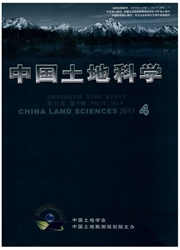

 中文摘要:
中文摘要:
研究目的:借鉴景观格局研究思路,构建耕地破碎度评价模型,利用1992年、2003年和2014年3期TM影像,对宁波市各县(市、区)耕地破碎状况进行综合评价,以期为区域耕地管理政策的制定和完善提供基础数据以及耕地破碎度的研究提供理论上的参考。研究方法:景观指数法,熵权法,自然分级法。研究结果:全市各评价单元耕地破碎度不断增加,1992—2003年耕地破碎度增加的幅度大于2003—2014年。全市耕地破碎度空间分布情况变化明显,1992—2003年两个Ⅰ级区转化为Ⅱ级区,一个Ⅱ级区转化为Ⅲ级区,2003—2014年,Ⅲ级区增加两个,全是由Ⅱ级区转化而来,Ⅰ级区只剩下一个。研究结论:全市耕地破碎度不断增加,地形复杂、经济发达的地区耕地破碎度偏大。
 英文摘要:
英文摘要:
The purposes of this paper are firstly to build a cultivated land fragmentation evaluation model so as to serve as an important reference for enacting land management policies,which is referred to the idea of landscape pattern,and secondly to evaluate the cultivated land fragmentation of each county in Ningbo based on the TM images in 1992,2003,and 2014.Methods of landscape pattern index,entropy-right method and natural break are employed in this paper.The results indicated that the degree of arable land fragment was increasing in all counties and the extent of arable land fragmentation increased more sharply during 1992—2003 than that during 2003—2014.During the period of 1992—2002,two I class areas converted to II class and one II class area converted to III class while from 2003 to 2014,two III class areas were newly added,both of which shifted from II class areas.It resulted in only one I class area being left.It is concluded that cultivated land in Ningbo is becoming more and more fragmental.Cultivated land fragmentation tends to be more serious in those areas with complex geographic features and highly-developed economy.
 同期刊论文项目
同期刊论文项目
 同项目期刊论文
同项目期刊论文
 期刊信息
期刊信息
